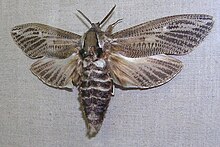Cossidae
Appearance
| Cossidae | |
|---|---|

| |
| Cossula magnifica (Cossulinae) | |
| Scientific classification | |
| Domain: | Eukaryota |
| Kingdom: | Animalia |
| Phylum: | Arthropoda |
| Class: | Insecta |
| Order: | Lepidoptera |
| Infraorder: | Heteroneura |
| Clade: | Eulepidoptera |
| Clade: | Ditrysia |
| Clade: | Apoditrysia |
| Superfamily: | Cossoidea |
| Family: | Cossidae Leach, 1815 |
The Cossidae, the cossid millers or carpenter millers, make up a
, which is mostly active during the day.
This family includes many species with large
mimics
, and Cossidae often have some sort of large marking at the tip of the forewing uppersides, conspicuous in flight, but resembling a broken-off twig when the animals are resting.
Caterpillars are smooth with a few hairs.[1] Most cossid caterpillars are tree borers, in some species taking up to three years to mature. The caterpillars pupate within their tunnels; they often have an unpleasant smell, hence another colloquial name is goat moths.
The family includes the carpenterworm (Chilecomadia moorei) are harvested in quantity and internationally traded as butterworms, for use as pet food and fishing bait.
Systematics
Some other animal families, such as the
Andesianidae which are even more ancient Heteroneura
.
The Cossidae were usually divided into six
subfamilies
have been described recently, the current taxonomy is:

- Subfamily Catoptinae
- Subfamily Chilecomadiinae
- Subfamily Cossinae
- Subfamily Cossulinae
- Subfamily Hypoptinae
- Subfamily Mehariinae
- Subfamily Metarbelinae(disputed)
- Subfamily Politzariellinae
- Subfamily Pseudocossinae
- Subfamily Ratardinae (disputed)
- Subfamily Stygiinae
- Subfamily Zeuzerinae

- Genera Incertae sedis:
- Acritocera
- Anastomophleps
- Archaeoses
- Charmoses
- Dolecta
- Eusthenica (or in Glyphipterigidae)
- †Gurnetia
- Huayna
- Psychidarbela
- Ptilomacra
- Schausiania
Excluded genera
- Moth genera now included in Dudgeoneidae
- Moth genera now included in Psychidae
- Adelopsyche
- Degia
- Hemilipia
- Mekla
- Trigonocyttara
- Westia
- Other
- Pecticossus
- Phragmatoecioides
- Pseudurgis
- Synaptophleps
- †Xyleutites
References
- ^ Hampson, G. F. (1892). The Fauna of British India, Including Ceylon and Burma: Moths Volume I. Taylor and Francis. Archived from the original on 2017-09-30. Retrieved 2018-01-14 – via Biodiversity Heritage Library.
- ^ Pitkin & Jenkins (2004) and see references in Savela (2006)
Further reading
- Pitkin, Brian & Jenkins, Paul. "Search results Family: Cossidae". Butterflies and Moths of the World. Natural History Museum, London. Retrieved February 28, 2009.
- Savela, Markku. "Cossidae Leach, 1815". Lepidoptera and Some Other Life Forms. Retrieved November 18, 2018.
External links
Wikimedia Commons has media related to Cossidae.
- Flickr Cossidae
